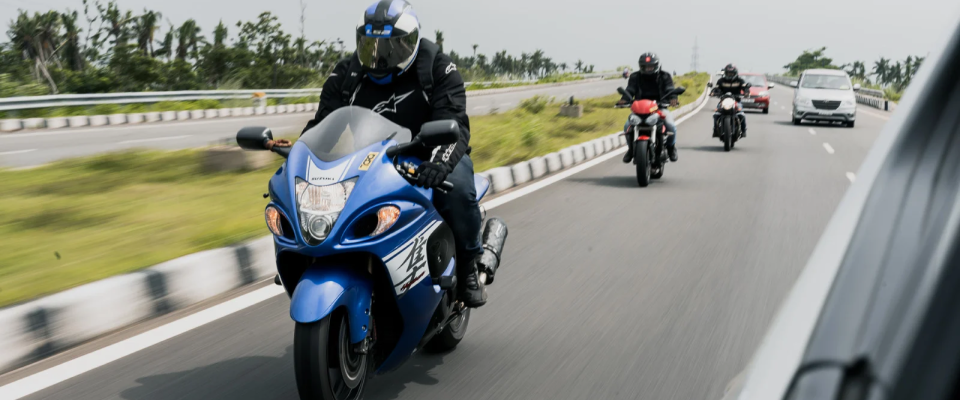Motorcyclists are some of the most vulnerable road users, and the most common motorcycle accident injuries are often severe. Nearly 1700 motorcyclists were injured on Virginia’s roads in 2022. Of those, 762 suffered serious injuries.
Some types of injuries are particularly rampant among Virginia motorcyclists. At Cooper Hurley Injury Lawyers, we’ve helped countless injured motorcyclists get fair compensation. Our experience gives us a unique perspective on motorcycle crash injuries, how they affect victims, and what causes them.
The 8 Most Common Injuries in Motorcycle Accidents
Motorcyclists lack the structural protection that other vehicles provide and are more likely to suffer severe injuries in an accident. Here are some of the most common injuries that we see among our clients.
1. Spinal Cord Injury
Motorcycle accidents often throw riders from their bikes at high speeds, causing them to directly strike the road or other objects. Impact from any angle can result in spinal cord damage.
Spinal cord injuries can cause partial or total paralysis. Other spinal cord injury symptoms include:
- Numbness or tingling
- Weakness
- Pain
- Difficulty breathing
- Bladder or bowel control issues
- Sexual function changes
The extent of these symptoms will depend on the severity and location of the injury. Spinal cord injuries are often permanent.
2. Road Rash
Road rash is a painful skin injury that occurs when a motorcyclist’s body slides across the pavement. Both exposed and covered skin may experience road rash, but clothing can reduce the likelihood of severe road rash.
Road rash severity depends on how deep the burn goes into the skin. Superficial road rash only affects the outermost skin layer, while full-thickness road rash reaches the fat layer underneath the skin.
Minor road rash injuries usually heal with basic first aid within a week or two. Severe road rash may require intensive medical treatment, such as skin grafts. Permanent scarring and infections are possible complications of road rash.
3. Head & Traumatic Brain Injuries
Traumatic brain injuries, or TBIs, are among the most severe and life-threatening injuries from motorcycle accidents. They can occur from the initial impact’s force or the rider’s head hitting the pavement. Wearing a helmet can prevent severe TBIs, but they can still occur with a helmet due to the high speed of motorcycle accidents.
Severe TBIs can cause permanent brain damage that affects a person’s cognition, personality, and coordination. Potential symptoms of severe TBIs include:
- Prolonged loss of consciousness
- Seizures
- Weakness or numbness in the fingers and toes
- Extreme confusion
- Unusual behavior, such as agitation or combativeness
- Slurred speech
Even minor brain injuries, such as concussions, can have long-term effects on brain function. Victims may experience headaches, drowsiness, dizziness, light sensitivity, memory problems, depression, and more.
4. Broken Bones
Also known as bone fractures, broken bones are among the most common motorcycle crash injuries. They typically result from the body’s direct impact with another vehicle or the ground.
The legs, arms, and ribs are the most frequent bones to break in a motorcycle accident due to their placement and lack of protection. Other bones, such as the skull, collarbone, pelvis, and spinal vertebrae, also can break in a crash.
Broken bone severity can range from slight hairline fractures to full displacements with multiple bone segments detached from one another. Immobilization with splints or casts may treat mild fractures. More severe fractures often require surgery with rods, plates, screws, pins, and wires. Bone grafting also may be necessary in some instances. Some fractures never fully heal and cause permanent disability.
5. Internal Injuries
Motorcycle crashes can cause extreme blunt-force trauma, potentially precipitating life-threatening internal bleeding. This condition isn’t always obvious right away and can quickly become dangerous if left to progress without treatment.
Abdominal trauma also can damage internal organs in motorcycle accidents, including the lungs, heart, liver, and other vital organs. This damage may include tears in the organs. Immediate medical attention, such as surgery and blood transfusions, is often necessary to control internal bleeding and repair organ tears.
6. Facial Trauma
The face is highly vulnerable to damage in a motorcycle accident. Broken bones, including the nose, jaw, cheekbones, and teeth, are common injuries. Riders also may experience severe face lacerations, bruising, and burns from impact with the road or objects.
These injuries can cause significant scarring and permanent disfigurement. They often require reconstructive surgery and affect the victim’s self-esteem.
7. Amputations
Amputation is the loss of an arm or leg that can occur when the limb is crushed or severed in a motorcycle crash. Amputations are often surgical procedures that medical professionals perform on the scene or shortly after arrival at a hospital. A medical professional may choose to amputate a limb if they cannot save it or if keeping it endangers the victim’s life.
An amputation significantly affects a person’s daily life. The healing process is often long and painful. Victims may be unable to walk or perform tasks such as self-care, prompting feelings of grief, anger, and helplessness. Prosthetics and rehabilitation can help victims restore some functionality and independence.
8. Burns
Motorcycle accidents can expose riders to hot engine parts, exhaust pipes, and fuel. Tissue that comes into contact with these hot objects may sustain burn damage. The deeper the tissue damage and the larger the burned area, the more severe the burn injury.
Burns can cause pain, changes to the skin’s appearance, infections, scarring, and swelling. Severe burns may require skin grafts. Permanent scarring and loss of skin functionality, such as the ability to sweat or feel sensations, also can occur.
Can I Get Compensation for Motorcycle Accident Injuries in Virginia?
You may seek compensation if someone else’s negligence caused your motorcycle accident injuries in Virginia.
Your compensation may include any damages you suffered from your motorcycle accident, such as:
- Past, current, and future medical expenses
- Lost wages for the work you missed while recovering
- Diminished earning capacity for the injury’s long-term impact on your ability to work
- Disability-related expenses, such as in-home care and mobility equipment
- Pain and suffering
You also may receive punitive damages if the at-fault party intended to harm you or showed extreme recklessness. Virginia caps punitive damages at $350,000.
Calculating Your Damages
The value of your economic and non-economic damages will largely determine how much compensation you receive.
Some economic damages, such as diminished earning capacity, can be particularly challenging to value. We may consider many factors to calculate what your lifetime earnings would have been if the accident hadn’t happened, including your age, job history, and education. We’ll then compare this number to your post-injury earning capacity.
Valuing non-economic damages, such as pain and suffering, can also be complex because they’re more subjective than economic damages. Approaches like the multiplier or per diem methods can help our attorneys calculate the value of your pain and suffering.
How Can I Prevent Motorcycle Accident Injuries?
Riding a motorcycle is inherently dangerous. Nothing can guarantee protection from motorcycle accident injuries. However, a few simple measures can make injuries less likely.
Wear Protective Gear
Wearing the right motorcycle helmet can greatly reduce the odds of a severe head injury. Choose a helmet with the DOT symbol on the back, indicating that it meets Federal Motor Vehicle Safety Standards.
Additionally, covering your skin from the chest down with thick clothing can protect you from severe road rash and burns. Denim and leather are good options for jackets and pants. Wear leather gloves and boots to protect your hands and feet.
Practice Defensive Riding
Defensive riding can reduce your accident risk and also improve your chances of avoiding severe injury if an accident happens. The key to defensive riding is being aware of your surroundings, anticipating hazards, and avoiding risky maneuvers. Keep these defensive riding tips in mind:
- Improve your visibility with bright, reflective clothing and proper headlight usage.
- Apply your brakes smoothly but firmly when stopping.
- Avoid riding in other vehicles’ blind spots.
- Signal turns and lane changes.
- Scan your surroundings from all angles frequently.
- Leave plenty of space between you and other vehicles.
- Check your blind spots and mirrors before changing lanes.
Take Motorcycle Safety Courses
Safety courses like those offered by the Motorcycle Safety Foundation can improve your skills and reduce your accident risk. These courses offer practical experience in handling various riding conditions. Consider taking a motorcycle safety course before you start riding and every few years afterward to refresh your skills.
How Cooper Hurley Injury Lawyers Can Help You With Common Motorcycle Accident Injuries in Virginia
Motorcycle accident injuries can have profound physical, emotional, and financial effects on your life. You deserve fair compensation if someone else is responsible for your suffering. When you turn to Cooper Hurley Injury Lawyers after a motorcycle accident, we’ll help you seek justice so you and your loved ones can start moving forward.
We’re dedicated to leveling the playing field between powerful insurance companies and motorcycle accident victims. Our approach has netted numerous favorable client results, including a $7 million verdict for an injured motorcyclist.
We’re ready to put our experience to work for you, so contact us online or call (757) 333-3333 for a free consultation.





